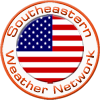Winter/Snow Storms Explained |
A winter storm is any combination of heavy snow, blowing snow and/or dangerous wind chills. A winter storm can be life-threatening.
Blizzards are dangerous winter storms that are a combination of blowing snow and wind resulting in very low visibilities. While heavy snowfalls and severe cold often accompany blizzards, they are not required. Sometimes strong winds pick up snow that has already fallen, creating a ground blizzard (also referred to as blowing snow).
An ice storm is a storm which results in the accumulation of at least .25" of ice on exposed surfaces. They create hazardous driving and walking conditions. Tree branches and power lines can easily snap under the weight of the ice.
Lake effect storms are not low pressure system storms. Lake-effect snow is produced during cooler atmospheric conditions when a cold air mass moves across long expanses of warmer lake water, warming the lower layer of air which picks up water vapor from the lake, rises up through the colder air above, freezes and is deposited on the leeward (generally to the south and east of the lakes) shores.
The areas affected by lake-effect snow are called snowbelts. These include areas east of the Great Lakes, the west coasts of northern Japan, the Kamchatka Peninsula in Russia, and areas near the Great Salt Lake, Black Sea, Caspian Sea, Baltic Sea, and parts of the northern Atlantic Ocean.
A lake-effect blizzard is the blizzard-like conditions resulting from lake-effect snow. Under certain conditions, strong winds can accompany lake-effect snows creating blizzard-like conditions; however the duration of the event is often slightly less than the required minimum for a blizzard warning to be issued by the government weather service organizations in either the US (NWS) and Canada (Environment Canada).
If the air temperature is low enough to keep the precipitation frozen, it falls as lake-effect snow. For lake-effect rain or snow to form, the air moving across the lake must be significantly cooler than the surface air (which is likely to be near the temperature of the water surface). Specifically, the air temperature at an altitude where the air pressure is 850 millibars (85 kPa) (roughly 1.5 kilometers or 0.93 miles vertically) should be 23°F (13°C) lower than the temperature of the air at the surface. Lake-effect occurring when the air at 850 millibars (85 kPa) is much colder than the water surface can produce thunder snow, snow showers accompanied by lightning and thunder (caused by larger amounts of energy available from the increased instability).
Snow squalls are brief, intense snow showers accompanied by strong, gusty winds. Accumulation may be significant. Snow squalls are best known in the Great Lakes region.
Winter Storm Specifics
Just like any other storm at other times of the year, the right combination of ingredients is necessary for a winter storm to develop. Those three basic ingredients are:
- Cold air. Below freezing temperatures in the clouds and near the ground are necessary to make snow and/or ice.
- Lift. Something to raise the moist air to form the clouds and cause precipitation. An example of lift is warm air colliding with cold air and being forced to rise over the cold dome. The boundary between the warm and cold air masses is called a front. Another example of lift is air flowing up a mountainside.
- Moisture. To form clouds and precipitation. Air blowing across a body of water, such as a large lake or the ocean, is an excellent source of moisture.
For more in-depth storm development information, please visit our "Understanding How Thunderstorms and Snow Storms Develop" page. With a few variations winter storms develop and act very similar to summer time storms, with few exceptions.
Winter Storm Precipitation Types
Most precipitation that forms in wintertime clouds starts out as snow because the top layer of the storm is usually cold enough to create snowflakes. Snowflakes are just collections of ice crystals that cling to each other as they fall toward the ground. Precipitation continues to fall as snow when the temperature remains at or below 32°F (0°C) from the cloud base to the ground.
- Snow Flurries. Light snow falling for short durations. No accumulation or light dusting is all that is expected.
- Snow Showers. Snow falling at varying intensities for brief periods of time. Some accumulation is possible.
- Snow Squalls. Brief, intense snow showers accompanied by strong, gusty winds. Accumulation may be significant. Snow squalls are best known in the Great Lakes Region.
- Blowing Snow. Wind-driven snow that reduces visibility and causes significant drifting. Blowing snow may be snow that is falling and/or loose snow already on the ground and being picked up by the wind.
- Blizzards. Winds over 35mph with snow and blowing snow, reducing visibility to 1/4 mile or less for at least 3 hours.
Sleet
Sleet occurs when snowflakes only partially melt when they fall through a shallow layer of warm air. These slushy drops re-freeze as they next fall through a deep layer of freezing air above the surface, and eventually reach the ground as frozen rain drops that bounce on impact.
Freezing Rain
Freezing rain occurs when snowflakes descend into a warmer layer of air and melt completely. When these liquid water drops fall through another thin layer of freezing air just above the surface, they don't have enough time to re-freeze before reaching the ground. Because they are ?super-cooled,? they instantly re-freeze upon contact with anything that that is at or below 32°F (0°C), creating a glaze of ice on the ground, trees, power lines, or other objects. A significant accumulation of freezing rain lasting several hours or more is called an ice storm.
Frequently Asked Questions:
Can it ever be too cold to snow?
- It rarely snows when the temperature drops below zero degrees Fahrenheit because the atmosphere is too stable. One of the ingredients for snow is enough lifting of saturated air that snow can develop aloft and fall to reach the surface. When it is said, "it is too cold to snow," in reality it means there is not enough lifting of air to cause snow to reach the surface. Even at very cold surface temperatures, significant snowfall can occur. Intense lifting can produce significant precipitation, even at very low temperatures. The temperature higher in the atmosphere can be much warmer than the air temperature at the surface, and that warm air aloft can hold more moist air than the colder air at the surface. And, moisture can be transferred into the area where lifting is occurring through advection (the horizontal movement of an air mass).
What is Thunder Snow?
- Although thunderstorms are less common in the winter, there are times when lightning can occur within snow storms and is called thunder snow. Thunder snow can be found where there is relatively strong instability and abundant moisture above the surface, such as above a warm front. Thunder snow is more commonly observed downstream of the Great Salt Lake and the Great Lakes during lake-effect snow storm events but can and does happen in any location in the US where the conditions are met.
How many inches of snow equals one inch of rain?
- On average, thirteen inches of snow equals one inch of rain in the US, although this ratio can vary from two inches for sleet to nearly fifty inches for very dry, powdery snow under certain conditions. The best way to find the water content of snow is to take a core sample and melt it down into a approved NWS or CoCoRaHS rain gauge.
What is a Nor'Easter?
- Rather than answer this here, please visit our page What is a Nor'Easter? which specifically addresses and provides in-depth information regarding this serious and potential life-threatening winter weather event.










